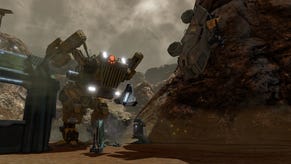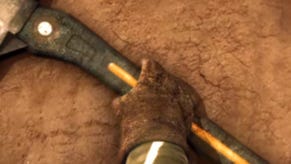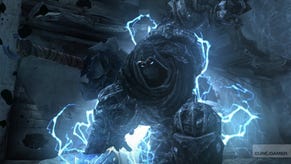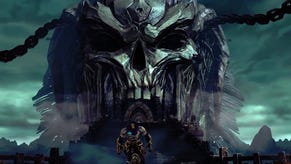Tech Comparison: Red Faction Guerrilla PC
Mission to Mars.
Options and tweakables in the graphics department are fine, but not hugely impressive. Aside from the usual resolution settings, there's this screen of selectables, seen here at "medium" and "high" settings respectively. Ambient occlusion and sun shafts don't appear to be on the console builds (nor if you're running DirectX 9 on the PC) and anti-aliasing is set to 2x on Xbox 360 and is not active at all on PS3. It's worth pointing out that while the AO and sun shaft options aren't active by default in high-quality mode, they didn't appear to impact performance by that much on my hardware. Otherwise the high quality setting is well-judged for reasons we'll get into shortly.
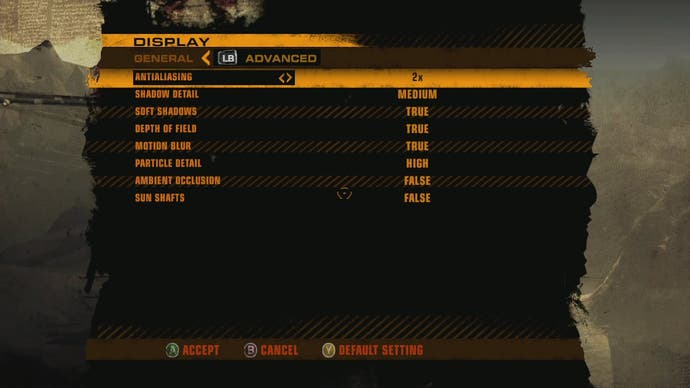
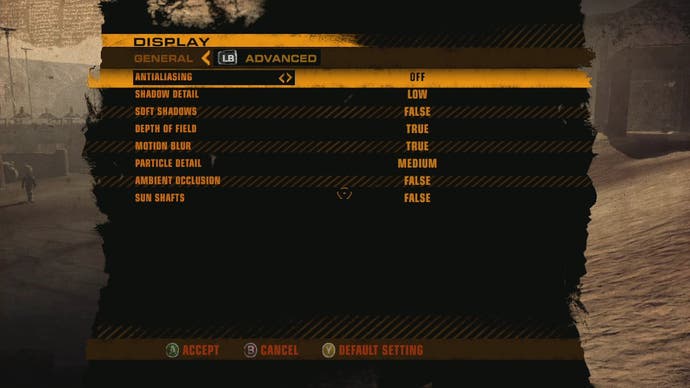
And here's a quickie comparison shot showing the Xbox 360 version of the game in the same gameplay area as the PC version, with the big difference being that the AO and sun shafts are fully engaged.
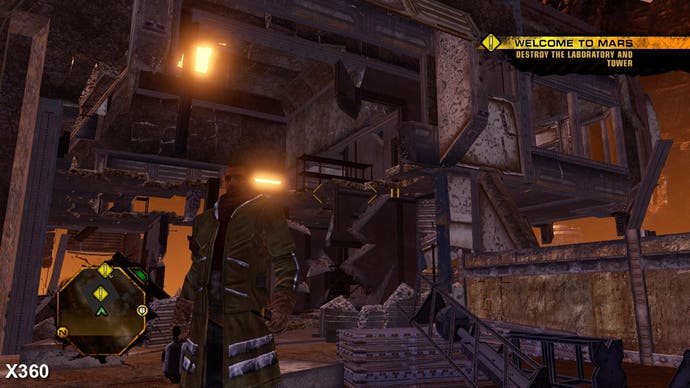

What is interesting to note is that there are no selectables involving texture quality, or LODs. Effectively the consoles are setting the standard here. Also note the deeply disappointing omission of a v-sync option. Screen tear was the main issue with the console builds, and you can't get away from it here either. There is no frame-rate limiter, so even if you have ultra-powerful hardware running the game at 150FPS, it's still going to tear. Your only option for a v-synced game is to dig into your GPU's control panel and attempt to force it via hardware. I did that, and combined with triple-buffering I saw a drop in overall frame-rate, but a smoother and obviously better-looking image. It's really puzzling that I should be forced into delving into my GPU's hardware options to get performance settings I would expect to find in-game.
In terms getting a decent game, you're going to need at least an entry-level enthusiast's GPU in order to get a decent experience, and if you don't have one, you're probably better off picking up a console. I'd say that a 9600GT or equivalent should be the base hardware, but you should get console-beating performance at 720p or 1280x1024 with something like a 9800GT or GTS250/9800GTX. Bearing in mind that these cards can be acquired in the £80-£90 range now, that's pretty decent going.
Thanks to a much appreciated assist from ASUS and NVIDIA, I was able to test the game with a number of different GPUs - the GTS250, the GTX260, and the GTX275 - alongside my standard games machine graphics card, the monstrous GTX295.
We're talking about graphics hardware from across the range of enthusiast-level cards, with pricepoints from £80 to £350, but what is rather strange is that no matter which card I used, and how much raw power I threw at the game, Red Faction's explosions cause an immediately apparent frame-rate hit. You would expect this to mean that the game is CPU limited, but looking at the performance of each core individually I didn't see any mad-crazy spikes or bottlenecks that would explain this. Bottom line: none of the kit I had available could sustain 60FPS at 720p, let alone 1080p.
I found that the shadow levels and AA were by far the most impactful options on performance. I scaled back AA to 2x, and knocked shadow detail down to medium. Using the most powerful hardware for the game that I had - the GTX275 - I found that I could run 1080p on those settings at a max of 35FPS, and a minimum of around 20FPS. That is roughly equivalent to the performance of the console versions at 720p but still rather unsatisfactory all told. With some strategic fiddling of the NVIDIA control panel, I settled on 1080p performance on high quality levels at what was very close to a sustained 30FPS using the i7/GTX 275 combo. What surprised me was that at 1080p, the GTX295 - the flagship in NVIDIA's range - was eclipsed by the far cheaper GTX275, suggesting that in our submission code, SLI and dual GPUs are not being utilised particularly well at higher resolutions.
What I want from PC conversions of console games is pretty straightforward. I want to be liberated from the limitations of the PS3 and Xbox 360 versions, and with the vast amounts of horsepower I have available compared to what's packed into the Sony and Microsoft boxes, I don't think I'm asking for too much. I want 1080p at a sustained 60FPS as standard, with 4x AA. In the case of Red Faction: Guerrilla, where the bloom effects serve to minimise aliasing issues to some degree, 2x AA would suffice, but even on these settings, I can't get the performance I want.
Overall then, I'm in two minds about this conversion. There are many things it does right: THQ has attempted to make the wait worthwhile by giving PC owners valued-added extras that console owners need to download for a premium. Computer owners get it all "out of the box" and that's brilliant. Not only that, but the game should work well on a variety of lower-level enthusiast hardware - Intel's £50 2.6GHz dual-core Pentium should perform decently with this, in concert with a well-chosen, inexpensive graphics card. That opens up RFG to just about any modern desktop PC, so long as it has a worthwhile, but hardly mega-expensive GPU upgrade.
However, the focus of the performance has effectively been to match what the consoles are doing and there appears to be little love for the PC enthusiast with high-end gear - the puzzling lack of performance with the GTX295 at 1080p was a somewhat unwelcome surprise. The 1080p frame-rates even on the higher-end cards is rather low in hectic gameplay, to the point where a v-synced Crysis at 1080p on high quality levels significantly outperforms Red Faction: Guerrilla. Sure, I can lower bling levels to bring the performance up, but the bottom line is that I want a game that exceeds console quality, and I won't be getting that then.
In short, Red Faction: Guerrilla looks set to succeed as a conversion that should please most of the people likely to play it, but in this review submission form, while it is relatively easy and inexpensive to exceed console performance, it is puzzlingly short of grunt for the gamers most invested in their hardware.

